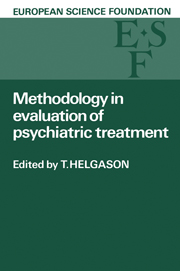 Methodology in Evaluation of Psychiatric Treatment
Methodology in Evaluation of Psychiatric Treatment Book contents
- Frontmatter
- Contents
- Participants
- Foreword
- Preface
- INTRODUCTION
- I METHODS OF CLASSIFICATION
- Principles of ‘Multiaxial’ Classification in Psychiatry as a Basis of Modern Methodology
- Standardized Methods of Classification of Mental Disorders
- The Significance of Biological Factors in the Diagnosis of Depressions
- II EVALUATION CRITERIA
- III RATING METHODS IN EVALUATION OF TREATMENT
- IV OTHER QUANTITATIVE METHODS OFEVALUATION OF TREATMENT
- V ETHICALAND PRACTICAL PROBLEMS
- Index
Principles of ‘Multiaxial’ Classification in Psychiatry as a Basis of Modern Methodology
from I - METHODS OF CLASSIFICATION
- Frontmatter
- Contents
- Participants
- Foreword
- Preface
- INTRODUCTION
- I METHODS OF CLASSIFICATION
- Principles of ‘Multiaxial’ Classification in Psychiatry as a Basis of Modern Methodology
- Standardized Methods of Classification of Mental Disorders
- The Significance of Biological Factors in the Diagnosis of Depressions
- II EVALUATION CRITERIA
- III RATING METHODS IN EVALUATION OF TREATMENT
- IV OTHER QUANTITATIVE METHODS OFEVALUATION OF TREATMENT
- V ETHICALAND PRACTICAL PROBLEMS
- Index
Summary
Introduction
In all branches of medicine, the establishment of a clinical diagnosis generally proceeds in the following way: the first step consists in the unbiased collection of the abnormal phenomena which the individual patient exhibits at present (examination data) or has previously shown (anamnestic data). In the second step the examiner will screen the identified symptoms in order to choose those which point, independently or in a characteristic combination, to a nosological entity or, more frequently, to several nosological entities. In the latter case, a third step becomes necessary in which the differential diagnosis is established by utilizing additional sources of information such as laboratory findings, anamnestic data of exposure to toxic substances, etc.
In psychiatry, the problems involved in the first step do not differ essentially from those encountered in other fields of medicine. They concern mainly efficient means of avoiding a biased selective registration of the abnormal phenomena by developing appropriate systems of standardized data recording. During the second step toward diagnosis however, psychiatry faces difficulties much less frequently encountered in most of the other medical disciplines, in which the choice of those symptoms to which a diagnostic significance can be attributed is reached on the basis of a savoirmedical (Debray 1969), a knowledge acquired by medical science on the basis of proven relations between certain symptoms or syndromes and specific aetiologies or pathogeneses. In the case of many mental abnormalities, the significance attributed to symptoms or syndromes cannot be controlled by aetiological or pathogenetic references. The choice of significant symptoms in this step depends on hypothetical nosological entities which vary considerably from school to school. Some of them content themselves with using arbitrarily chosen symptoms or syndromes as hypothetical nosological entities as long as aetiological and pathogenetic research does not provide conflicting evidence. Others attempt meanwhile to find some confirmation of their hypotheses in other areas, such as onset, natural course and outcome, response to different types oftreatment, genetic findings, etc. It is obvious that the shortcomings of the second diagnostic step weaken the thirdone. If a psychopathological syndrome is identified by means of a hypothetical nosological entity without the possibility of positive aetiological proof, only the evidence of an aetiology other than the supposed one retains a differential diagnostic value.
- Type
- Chapter
- Information
- Methodology in Evaluation of Psychiatric TreatmentProceedings of a Workshop Held in Vienna 10–13 June 1981, pp. 71 - 80Publisher: Cambridge University PressPrint publication year: 1983


